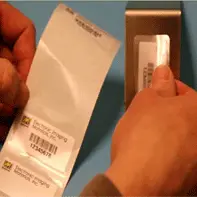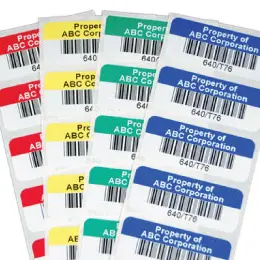
Your inventory data is sacred; it should never be adjusted or compromised in order to fit in a barcode. Nonetheless, variables like surface area and number of characters in your data can influence the way they’re applied to your samples and equipment. That’s why we ask questions first before preparing your order; ensuring barcodes are the right fit for your laboratory.
Labels with a Ladder – 1D Barcodes
The length of your data, or number of characters in each string, plays a big part in finding the right barcode. The data encoded in the barcode will significantly affect its size. Consider the difference the number of characters can make in the picture to the left. These vials are 75mm and 45mm in length. Now think about the data you’ll be converting into barcodes, and the size of the vials, slides, or plates you’ll be labeling. Do your data pieces contain more than 10-12 characters? An example would be 123456789-ABC, or NEW-HAMPSHIRE-KEENE. If so, a 2D barcode may be more accommodating.
Down to a Square – 2D Barcodes
 If your data contains long character lengths such as a website URL, or simply needs to be compact in size, 2D barcodes could provide a solution. Because of their modest size, it’s possible to label the top of capped tubes and vials too, like in the picture to the right.
If your data contains long character lengths such as a website URL, or simply needs to be compact in size, 2D barcodes could provide a solution. Because of their modest size, it’s possible to label the top of capped tubes and vials too, like in the picture to the right.
However, 2D barcoding isn’t without nuances. Your scanner must be compatible to read 2D barcodes. If you’re labeling tubes and vials, the diameter can’t be too narrow and cause the barcode to curve too much. This would render it useless. We generally recommend at least 10mm in diameter for tubes and vials.
Too Much Info? We Get That A Lot…
You don’t need to know every intricacy of barcoding before giving us a call. It’s useful to use this as a guide for the type of barcoding that is available, but we’ll always take the time to gather the right information about your application and create a solution for you. We’ll ask questions along the way, but it will be more about what you’re looking for, not loaded technical jargon!





